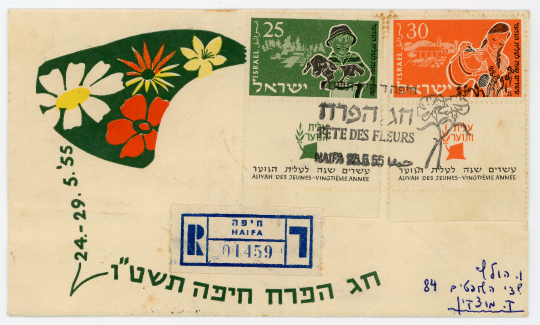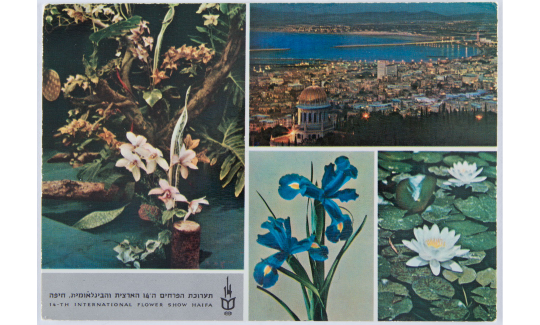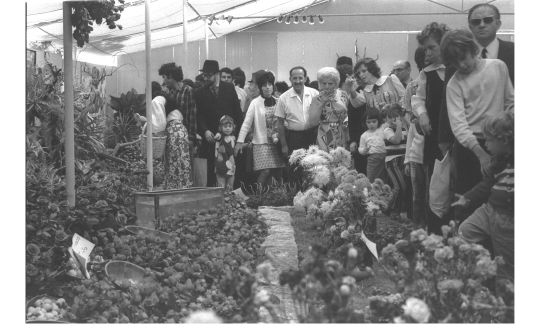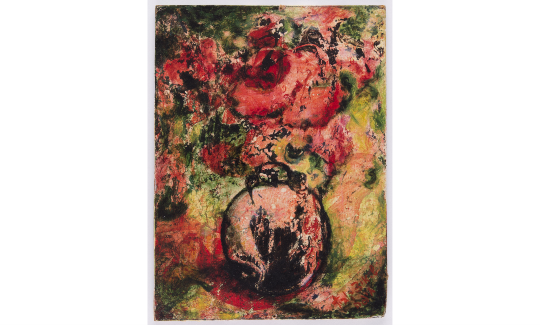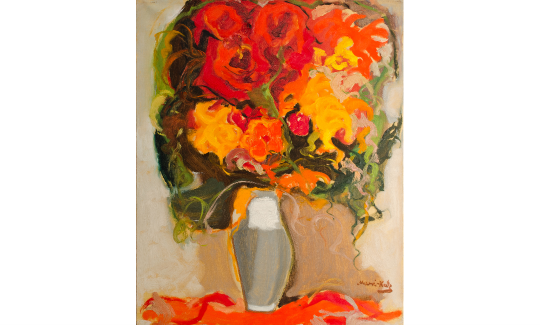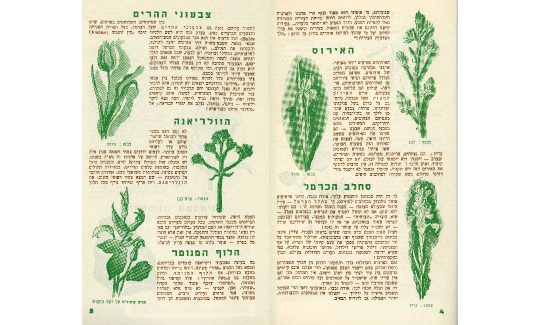The Flower Show: A Historical View and a New One
Saturday, 01.07.23, 20:00
Saturday, 03.08.24
curator:
Yifat Ashkenazi
More info:
04-6030800The historic “Flower Show” returns to Haifa
The traditional Haifa festival that was celebrated over four decades returns to the Haifa City Museum. Visitors will be introduced to the nostalgic history of the Flower Show and the city of Haifa, and at the same time discover a new and refreshing perspective of this special festival.
The annual Flower Show was celebrated in Haifa from 1951 to the mid-1990s. In 2012, in a one-time moment of nostalgia, it was revived to pay tribute to the veteran Haifa event. The exhibition, organized by the Haifa Municipality, displayed large flower arrangements and plants from around the world. The participants were nursery owners and florists, and Israeli visitors, among them many public figures, came in throngs from every corner of the country. The exhibition and its parallel events focused on the connection between people and flowers, captivating visitors with their colorful and fragrant charms.
The remarkable exhibition in the Haifa City Museum offers a nostalgic time odyssey back to past events, while simultaneously exposing visitors to a new celebration of color and fragrance. It raises questions about our connection as human beings with the flowers that surround us. Among the exhibits are items from the Haifa City Museum and other collections (historical photographs, documents, posters, artworks, and more), testimony to the development of the Flower Show over the years in all its facets:its physical and visual characteristics, as well as the emotions and responses it evokes.
As a mark of esteem, Yifat Ashkenazi, the curator of the Haifa City Museum, forged a connection with three countries: Taiwan, Lithuania and Japan. A separate room is devoted to each of them.
In cooperation with the Taipei Economic and Cultural Office in Tel Aviv, an exhibit was mounted that tells the story of a Taiwanese ethnic community called the Hakka. There is a tradition in Taiwan of a May festival dedicated to the blossoming of the tung, a tree much cherished by the Hakka. The annual festival is a great booster for local tourism, and manages to preserve the culture and tradition of an ancient history. The room gives a glimpse of the design and decorative art of the Hakka.
The museum, with the cooperation of the Lithuanian Culture Institute, invited Baltos Kandys (“White Moths”), a Lithuanian artists’ group, to participate in the exhibition. In the room dedicated to their art, the group displayed a ‘mandella’ carpet, made of felt ‘flowers.’ Its form
is composed of a system of repetitive shapes, a model that connects the material and the spiritual. Furthermore, the form of the mandella expresses the principle of infinity in the world.
One can view the form of flowers in the same way, since all flowers embody within them the mandella’s infinite, repetitive configuration.
With the support of the Embassy of Japan, workshops in ikebana, traditional Japanese flower arrangement, will take place from the morning of the opening day of the exhibition. Ten veteran ikebana instructors were brought out from Japan for the occasion, and they themselves will present examples of the art form at the official opening that evening. Another room in the exhibition has been assigned to the Japanese art of origami – paper-folding. Visitors can try their hand at creating four different flowers (no scissors, no glue), write a wish inside them, and attach them to a tree in the hope of the wish being fulfilled.
Gracing the Flower Show are three new artworks, created especially for the exhibition.
Visitors entering the central exhibition hall will pass through a “Gateway” of flowers, created by artist Ori Shifrin Anavi. The gateway is constructed from artificial flowers, in a spectacular variety of colors and shapes, establishing an aesthetic connection with the symmetries of Haifa’s Baha’i Gardens. At close range, the visitor realizes that the flowers that form the gateway are not real, but made of plastic: it is all an illusion. The use of plastic flowers also underlines the darker side of the flower industry, which depends to a great extent on artificial presentation to satisfy customer demand and reduce costs. It raises ethical issues for the two industries, the “organic” and the “artificial.”
The works of artist Albina (BINI) Chizik – wilting flowers – will be given pride of place, hanging from the ceiling. BINI will create fresh flower arrangements, which will undergo the process of wilting and dehydration for the duration of the show, for all to see. As they change their form and color, the work assumes an entirely different character. The flower arrangements hanging from the ceiling form an enormous wall of fresh blooms. Chizik was a little girl when her family moved to Israel from Kyiv, in the Ukraine. She felt that flowers were always in her life: wall rugs with flower motifs that appear in family pictures; the floral frocks her parents dressed her in; and the flowers she saw here in Israel, which gave her a sense of belonging.
Artist Suzi Farkash offers another interpretation, creating flowers out of yarn, transforming
them into something akin to a soft and comforting rag doll. The work can be seen as a homage paid to the genre of still-life art. Artists have sought to freeze time by painting flowers in vases. Knitted or crocheted flowers similarly immortalize blooms, but in three dimensions, and often using synthetic threads that contradict the original organic nature of the flower. The knitted or crocheted flower preserves the colorfulness that people so love in living flowers, but can they preserve other qualities of the flower as well?
The museum walls display photographs by the renowned Haifa photographer Zvi Roger, who worked for the Municipality for many years. Those photographs that are part of the exhibition document the Flower Show of 2012 and how it was mounted..
The exhibition has many and varied interactive activities, suitable for all the family. It includes:
- A huge memory game about flowers and their symbolic significance, from which one can learn the meaning given to different flowers in different regions of the world, and the meaning of names given to certain flowers.
- A family ‘experience space’ with cushions and beanbags, children’s books and issues of children’s magazines deal with flowers and nature.
- A dark room with tablets that shine in the dark. Kids can draw flowers on them and learn about flowers that bloom only at night.
- Enjoy origami activities, learning to fold paper to make three-dimension flowers. Write wishes inside them, and attach them to a tree in the room.
- The encyclopedia, a botany room with explanations on the walls about flowers and plants, and an activity for children of creating flowers from pieces of felt.
- The museum courtyard is part of the fun as well. The area will be filled with real flowers, but also with huge wooden blossoms that offer an interactive family activity of using cotton threads to fill the stamens with “pollen”! (The game was developed by Mor Shachor, education coordinator of the Haifa City Museum.)
In addition to the activity rooms, and the activity in the outdoor courtyard, visitors can enjoy a digital game of searching for flowers. Enter the game on your smartphone to identify specific specimens in the exhibition. The “target” flowers are integrated into the exhibition in different ways: in artworks, posters, photographs, and more. The game is suitable for the whole family, and provides a ‘frontal’and digital experience at the same time, with an enjoyable innovative way of acquiring information that is at the heart of the exhibition. (The digital game was developed by the digital coordinator, Yael Grossman Arzuan.
Apart from its regular activities, the Haifa City Museum has planned many additional activities
for the duration of the exhibition: workshops, lectures, outside events, a ‘happening’ for children, and more. Updates are available on the site of the Haifa Museum.

